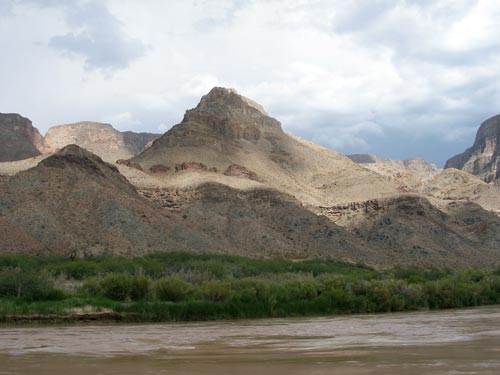The sun crested the cliffs early and not surprisingly, it got very hot quite quickly. We rafted down to Parashant Wash at mile 198.5 and took a short walk. The wash is supposedly home to something called the Book of Worms, a house-sized rock filled with the perfectly preserved tracks of burrowing marine worms that lived in the Cambrian mud over 500 million years ago. We never did find it.

Walking along the currently dry wash

Towering canyon walls

Not the Book of Worms but worm tracks none the less

Nautiloid fossil. Nautiloids are a group of marine mollusks that flourished around 500 million years ago as the main predatory animals. They developed an extraordinary diversity of shell shapes and forms. Some 2,500 species of fossil nautiloids are known, but only a handful of species survive today. They are often called 'living fossils'.

The ocotillo is covered with thorns. This is a unique desert plant of the southwestern United States and northern Mexico. For much of the year, it appears to be an arrangement of large spiny dead sticks, although closer examination reveals that the stems are partly green. With rainfall, the plant quickly becomes lush with small leaves, which may remain for weeks or even months.
For the most part, it was a nice slow cruise down the river with only minor rapids.... but minor rapids can still cause trouble. At one point, we hit an unexpected hole at 205 Rapid. The raft suddenly tipped sideways and we plunged to the bottom of the large water pocket. I found myself looking directly up at an enormous wall of water! I turned quickly to look back at the oarsman but was greeted with an even scarier image... the oars had been knocked from his hands and he was frantically trying to get things back under control. I prepared myself to be dumped into the shockingly cold water at any second... but somehow he managed to pull us out of it.
The shifting clouds provided a wonderful play of light on the surrounding cliffs.



The different layers of rock are very distinctive in the distant cliffs.



Tonight, home was at 209 Camp. A giant storm swept in quickly. The wind whipped around us, driving the rain down even harder. Enormous bolts of lightning flashed through the sky with deafening sound. The sky began to glow with shades of pinks and purples. It was surreal and made us savor the feeling of being truly alive.

Everyone enjoys the peaceful sunset.

The setting sun becomes masked by the clouds.

The approaching storm

The rain begins to fall and the temperature drops quickly.




Keeping warm

Such storms often cause flash floods in the side canyons, especially at Diamond Creek (the location of our take out in two days). If the road there gets washed out, then we would have to continue on for a couple more days to Lake Mead. Only time will tell.
return • continue

